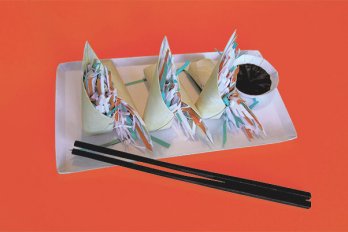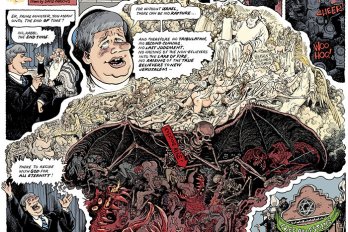Library-quiet, fluorescent lit and immaculate, Mirko Betti’s lab at the University of Alberta, in Edmonton, looks like the kind of place a chef—in particular, a molecular gastronomist—would love. Instead of stoves and chopping blocks, a gas chromatography machine (to analyze nutrients in meat protein) occupies one nook. Elsewhere, grad students huddle around various equipment, testing the texture, taste, and nutritional content of animal protein, reducing the saltiness of meat here, increasing levels of omega-3 fatty acids there. “He likes to keep the space as clean as a kitchen,” one assistant says. Still, for the lab of a food scientist, it shows a conspicuous absence of anything edible.
Betti works as a professor in the university’s Department of Agriculture, Food, and Nutritional Science, where he develops new meat products and improves existing ones. Since only about 70 percent of a chicken is typically processed for food, he finds novel applications for the other 30 percent, such as a translucent film made from poultry by-products that brings to mind plastic wrap. By removing fat and myoglobin (a red protein that stores oxygen in muscle cells), he has converted dark meat salvaged from poultry wings, legs, and thighs into more sought-after white meat; and he’s currently trying to improve the taste of meat from animals that have undergone stress before slaughter. Some observers might question the ethics of tinkering with the food we eat, but for Betti it’s a matter of perspective. “I don’t like the word ‘natural,’” he says. “I like to say that nature modifies nature. We are within nature; we are not external observers.” (Such ruminations guide his work, but he considers them too complex to discuss in an interview. “Let’s not talk about nature,” he explains, “because then we’d have to get into Kant.”)
He’s also involved in a more fantastical concoction, as part of an international network of independent researchers working on in vitro meat, an idea once relegated to science fiction novels; think of the vat-grown flesh depicted in William Gibson’s 1984 novel, Neuromancer, or the transgenic ChickieNobs of Margaret Atwood’s Oryx and Crake. These specialists, including stem cell experts, biologists, and food policy experts, hope to take an embryonic science from the lab to the supermarket. Contributions from food scientists like Betti—the only one doing this work in Canada—will be essential; if the stem cell researchers are the farmers, he is progressive chef Grant Achatz. “What I can do is make it taste as good or even better than what you’d find on the market,” he says.
Rooted in medical research, the science behind lab-grown meat is remarkably advanced. In the early twentieth century, a French biologist kept tissue cultured from an embryonic chicken heart alive for twenty years, and over the decades doctors have experimented with organ regeneration. In 2000, a scientist funded by NASA sliced a fillet from a live goldfish, placed it in a vat of embryonic cow blood, and watched it grow. University of Toronto bioengineer Milica Radisic nurses human heart tissue in her laboratory, and the acclaimed surgeon Anthony Atala generated a kidney on an enormous inkjet printer, laying down cells instead of ink. He also constructed a heart valve around biomaterial scaffolding; soon afterward, it was beating. As he said at the time, “It’s like baking a layer cake.”
Though driven by the quest to design the perfect food, Betti frames his research in ethical terms. “We’re already raising chickens only for their breasts,” he says, paraphrasing a prediction Winston Churchill made in 1932. “Why grow all those feathers? ” With annual consumption of animal protein projected to hit sixty-five kilograms per person by 2050 and the world’s population expected to reach nine billion, the ecological and economic implications of satisfying appetites present staggering challenges. Raised in a vat rather than a pasture, in a soupy protein mixture that would make even the hungriest carnivore’s stomach churn, manufactured meat could still become a sustainable and humane solution. So far, though, the science remains largely conceptual. Only grown by a few stem cell researchers, in vitro meat has not advanced sufficiently to even resemble ground round, and is said to have the consistency of undercooked eggs. Betti estimates that he and his colleagues are a decade away from figuring out how to make, say, Swedish meatballs, and even further from perfecting a lab-grown steak.
Under the Microscope
An early innovator in the field of mad science
Jennifer Spinner
While natural philosophers generally celebrated the invention of the microscope during the Scientific Revolution, Margaret Cavendish, Duchess of Newcastle, denounced it vociferously. Microscopic images were “hermaphroditical, that is, mixt figures partly artificial, and partly natural,” she wrote in Observations upon Experimental Philosophy (1668). “If the picture of a young beautiful lady should be drawn according to the representation of the microscope… it would not be like a human face, but rather a monster.” In addition to natural philosophy, Cavendish—an avid reader with no formal education—wrote poems, essays, and science fiction; in The Blazing World (1668), a noblewoman discovers a land of peaceful anthropomorphic animals beyond the North Pole. Although Cavendish’s contemporaries, who dubbed her “Mad Madge,” ridiculed her, modern scholars have praised her as a visionary. The Stanford Encyclopedia of Philosophy ascribes to her work an “early and very compelling version of the naturalism that is found in current-day philosophy and science.”
—Julie Baldassi
Inventing a food that has long been imagined but never fully realized is why Betti got into food science, first taking interest in lab-grown meat in 2003. While finishing his Ph.D. at the University of Bologna, he read Futurizzazione, a manifesto by the Italian economist and political scientist Carlo Pelanda on the power of technology to transform society. Betti was intrigued by Pelanda’s passing mention of artificial meat, and dazzled by the notion of technology as salvation. “It gave me a philosophy or a way of thinking about technology and about life,” he says in his heavy accent, over an eggplant sandwich and sweet potato fries at a restaurant near the university. Dressed in a black houndstooth blazer, knit vest, and tie, with dark, shoulder-length hair, he resembles an Italian David Beckham. “Technology has the power to save—I really like the word ‘save’—the world. It’s a Christian concept, but instead of God we have technology. It’s the language I use.” He glances down at the voice recorder, suddenly self-conscious. “I don’t want to say these things at the moment, because I’m writing a book.” (On another day, when pressed, he grows flustered: “I copyright this conversation.”)
The book will wed his philosophical ideas to his food research, although for Betti the two are already inextricably linked. “Mirko is one of the most creative researchers in the food science sector,” Pelanda says. “His need for philosophy is his driving force. Hope that he will survive a much narrower academic milieu. Help him.” On Betti’s website and his Facebook page, he quotes the Futurist Manifesto by Filippo Marinetti (whose 1932 Futurist Cookbook inspired ironic, avant-garde dinner parties, complete with towering meat skyscrapers and deep-fried roses): “There is no longer beauty except in the struggle. No more masterpieces without an aggressive character. Poetry must be a violent assault against the unknown forces in order to overcome them and prostrate them before men.” In his spare time, Betti reads Amartya Sen and Isaac Asimov; if he weren’t a scientist, he wouldn’t mind writing science fiction: “Science can be boring,” he admits. He posted a copy of his well-received paper about in vitro meat, published in Innovative Food Science and Emerging Technologies, on his website under the heading “Metaphysics of Food.” (He has since changed it to “Cibus Next”; the word cibus means “food for men and animals” in Latin.)
“Without metaphysical old philosophy,” he says, “we wouldn’t have science. Every scientist is a philosopher. Science is an ideology, no different from any other ideology, though it’s much more powerful. I’m probably a heretic saying this in a science community.” He looks apologetic, then adds, “It’s a kind of truth.” His beliefs may be unorthodox—but so is rib-eye grown in a test tube.
This appeared in the October 2011 issue.






